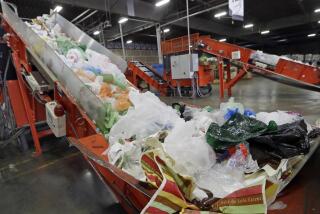Big Bear Packages a Worthy Concept
- Share via
Plastic grocery bags in recent years have become standard at most markets. Sometimes the bagger will ask “plastic or paper?” but, if they don’t, the likelihood is that you’ll be lugging groceries home in plastic sacks.
San Diego-based Big Bear Markets is trying to change this. In recent weeks the 30-store chain has started encouraging the use of paper bags once again. Plastic is still available, but paper is pushed.
Paper containers also have replaced plastic foam in Big Bear delicatessens, and the stores are sprinkled with signs trying to educate customers on such things as buying pump sprays rather than aerosol.
As with many environmental issues, the merits of plastic vs. paper packaging are hotly debated. For our money, paper sacks seem the better choice. But the arguments can get complicated. Plastic bags are less bulky, so they take less energy to transport and take up less room in landfills, goes one argument. But paper degrades more easily, is more readily recyclable and comes from a renewable resource.
Which products are environmentally safer will take years to sort out.
But there is no question that we need to produce less packaging. And Big Bear’s program addresses that as well. It will pay customers 2 cents for each large paper sack they bring back to be reused in packing their next grocery purchase.
That is a move in the right direction. Using a grocery sack two or three times genuinely means there will be less waste for the landfill and less pollution in manufacturing and transporting the packaging.
Two cents may not be enough incentive to prompt very many customers to bring their own bags to the supermarket, but it’s a start. And, combined with an aggressive marketing program, it helps promote recycling. It’s a way to make people stop and think about packaging and recycling in the grocery store--the place where we buy so much of what ends up in our trash.
More to Read
Inside the business of entertainment
The Wide Shot brings you news, analysis and insights on everything from streaming wars to production — and what it all means for the future.
You may occasionally receive promotional content from the Los Angeles Times.







